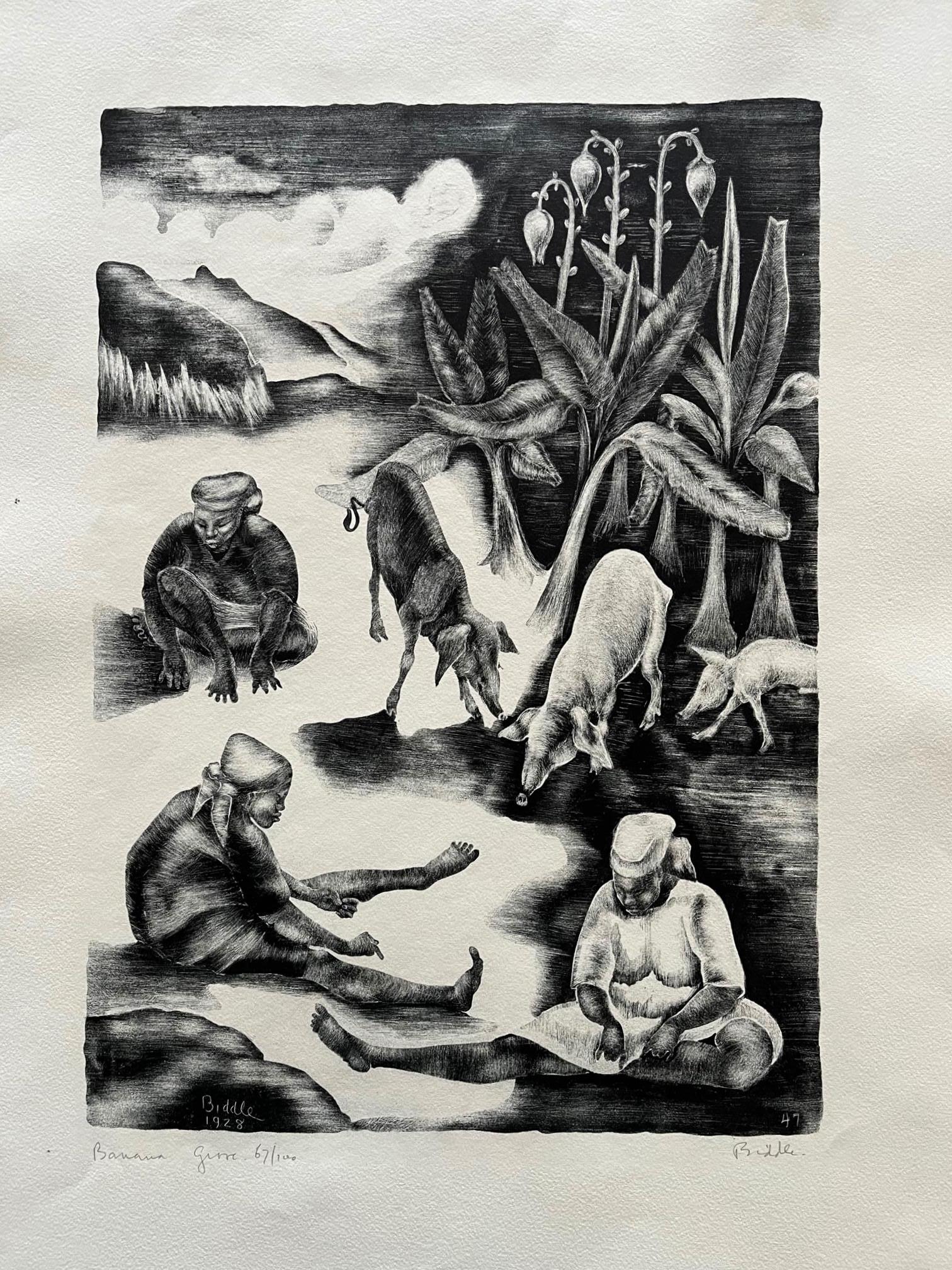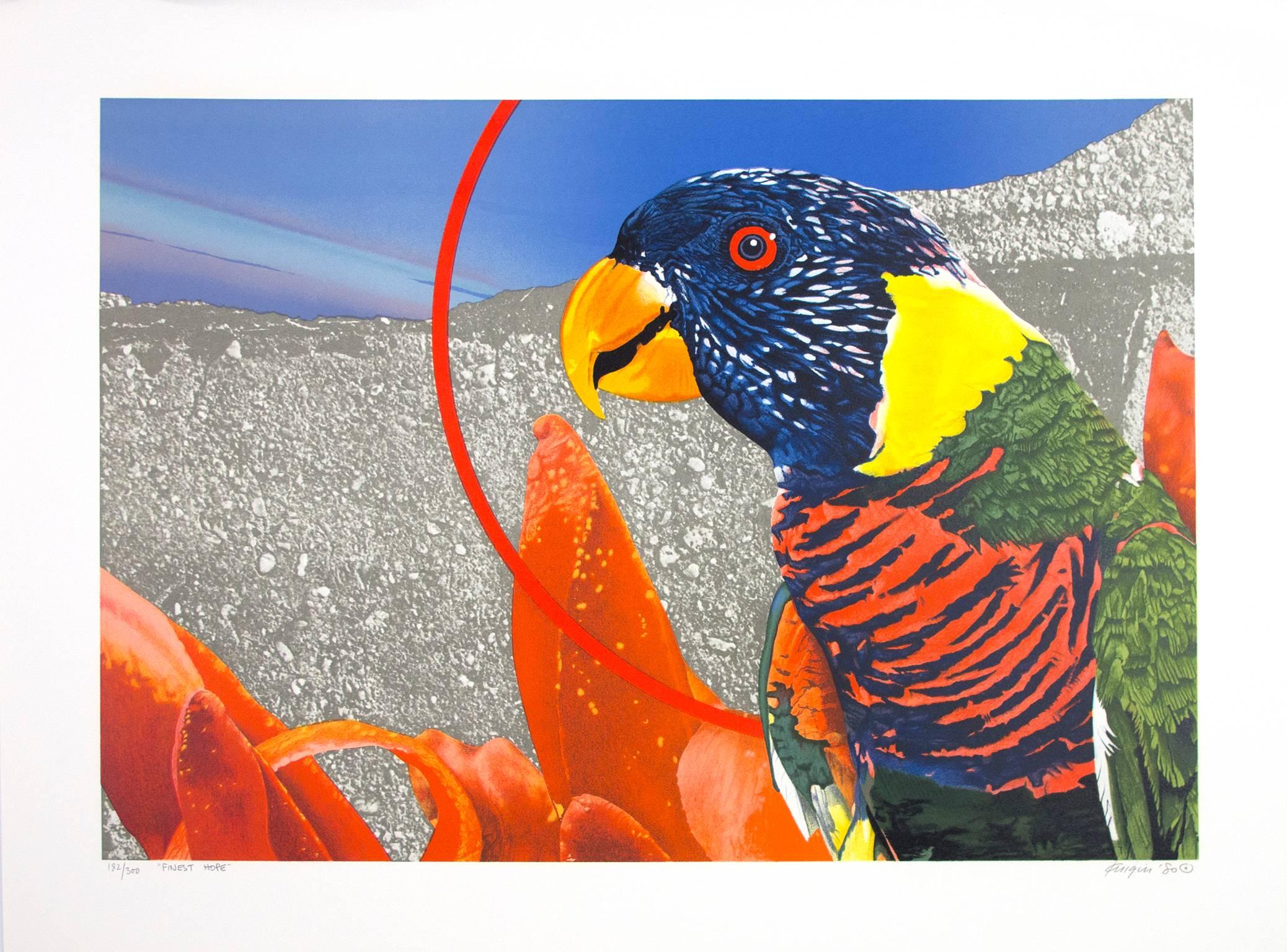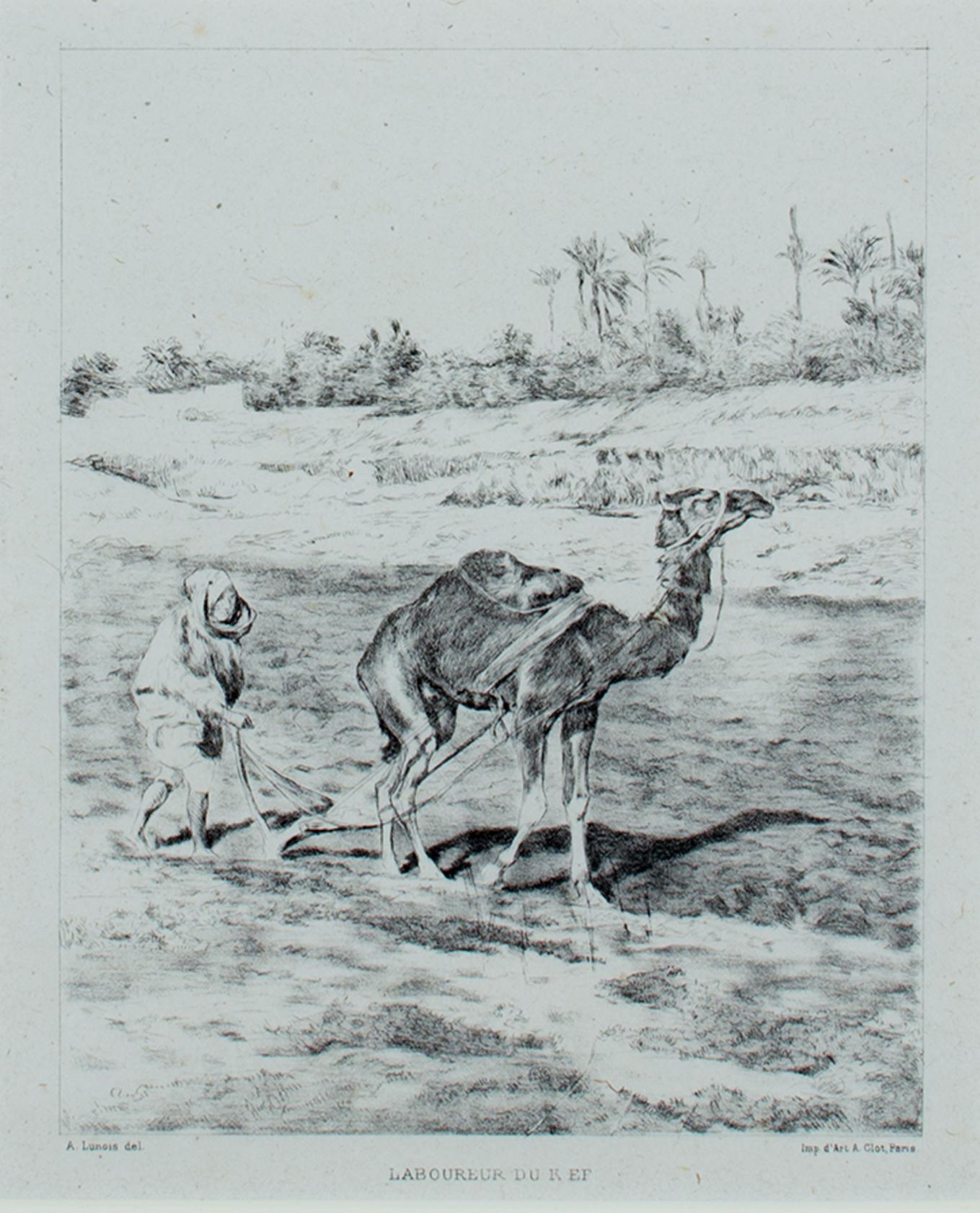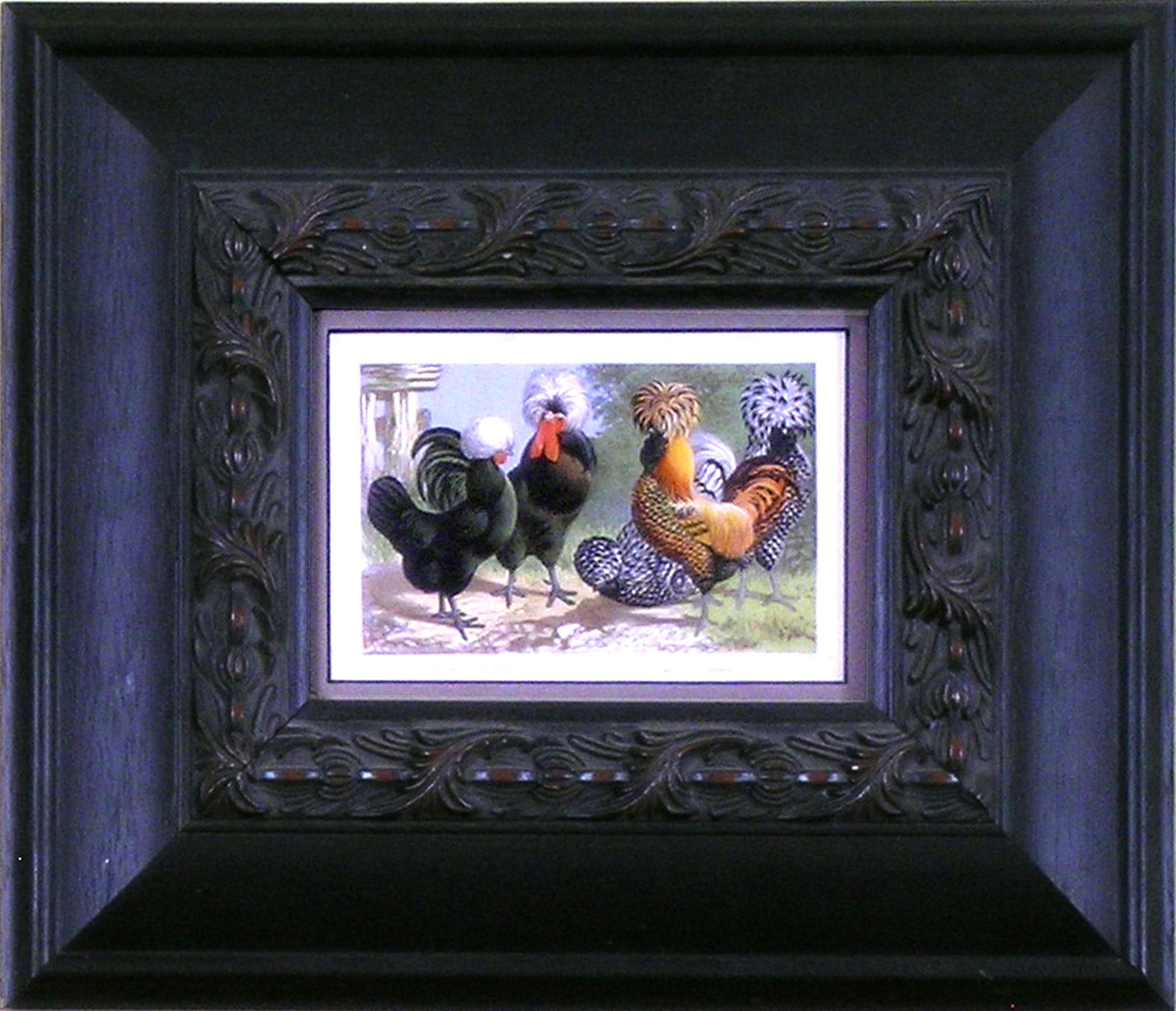Items Similar to Leucippus Fallax (Buffy Hummingbird) — Original 1849 Hand-colored Lithograph
Want more images or videos?
Request additional images or videos from the seller
1 of 7
John Gould and Henry Constantine RichterLeucippus Fallax (Buffy Hummingbird) — Original 1849 Hand-colored Lithographc. 1850
c. 1850
About the Item
John Gould, 'Leucippus Fallax' (Buffy Hummingbird), original lithograph with hand-coloring (not a reproduction), c. 1850. Signed in typeset 'J. Gould and H. C. Richter, del et lith.', lower left. A finely detailed lithographic impression with transparent oil and varnish hand-coloring on cream wove paper; the full sheet with wide margins. Several small spots of foxing (shown in the full-sheet image), minor glue stains in the left and right top sheet edge, verso (from previous hinges); otherwise in very good condition. Matted to museum standards, unframed.
Image size 12 x 10 1.4 inches; sheet size 21 3/8 x 14 1/4 inches.
From ‘A Monograph of the Trochilid, or Family of Humming-birds in Five Volumes’ v. 3, Printed by Taylor and Francis; published by John Gould, 1849, London.
Impressions of this work are held in prominent public collections, including Amherst College, Arts Council England, Australian Museum (Sydney), College of Charleston, Cornell University, Glasgow Libraries (University of Glasgow, Scotland), Royal Collection Trust ( Buckingham Palace, London), State Library of Victoria (Australia), and the Smithsonian Libraries and Archives (Washington DC).
ABOUT THE ARTIST
John Gould maintained an obsessive fascination for hummingbirds throughout his life: "These wonderful works of creation my thoughts are often directed to them in the day, and my night dreams have not infrequently carried me to their native forests in the distant country of America."
John Gould (1804 –1881) was born in England, on the Dorset coast but was brought up in Surrey and later Windsor, where his father was one of the gardeners at the castle. The young Gould taught himself taxidermy from an early age and soon established a skill for the craft. Following a brief 18-month stint as a gardener at Ripley Hall in Yorkshire, in 1824, he moved to London to establish a shop in the city.
The taxidermy enterprise was successful and Gould counted important public figures, including George IV (for whom he stuffed a pet giraffe in 1826), among his clients. In 1828, he won a competition to become taxidermist at the Museum of the Zoological Society of London and eventually became the curator of the museum, where he developed connections with some of the most prominent naturalists of the day and received specimens from around the world to preserve and prepare for display. He was also noted for his own knowledge of ornithology and, in 1836, assisted Charles Darwin in understanding the specimens collected from the Beagle voyage to the Galapagos, demonstrating that the birds collected were not different species as Darwin initially thought but varieties of the same species, thus inspiring his revolutionary theory of natural selection.
Gould began to publish fine ornithological volumes in 1830. They are among the most famous and important 'bird books' of the nineteenth century, and the volumes in the Royal Library were subscribed to by Prince Albert and Queen Victoria.
Gould's passion was for hummingbirds. Though not seeing one alive until a specially arranged trip to the United States in 1857 specifically for that purpose, he collected over 1,500 different birds from across 300 species, going so far as to display them to the public at the Zoological Garden of the Great Exhibition in 1851. Between 1849 and 1861, Gould published his most beautiful work, '‘A Monograph of the Trochilid, or Family of Humming-birds', containing finely painted illustrations of these tiny birds based upon the stuffed specimens in his collection. The major achievement of Humming-birds is the inclusion of gold leaf under the colouring to replicate the iridescence of the animals' plumage. The practice was not new; naturalists painting watercolor over gold leaf to show iridescence in feathers and in the scales of fish since the beginning of the century. Gould learned the technique from correspondence with the American ornithologist William Lloyd Baily (1828-61). However, Gould's innovation, employed by Henry Richter, who painted many of the birds, was the use of oils and varnish instead of watercolors to produce a brilliancy never before seen on the page.
—excerpted from the introduction to the artist, Royal Collection Trust, Buckingham Palace, London
- Creator:John Gould and Henry Constantine Richter (1804 - 1881, English)
- Creation Year:c. 1850
- Dimensions:Height: 12 in (30.48 cm)Width: 10.25 in (26.04 cm)
- Medium:
- Movement & Style:
- Period:
- Condition:
- Gallery Location:Myrtle Beach, SC
- Reference Number:
About the Seller
5.0
Recognized Seller
These prestigious sellers are industry leaders and represent the highest echelon for item quality and design.
Platinum Seller
These expertly vetted sellers are 1stDibs' most experienced sellers and are rated highest by our customers.
Established in 1995
1stDibs seller since 2016
254 sales on 1stDibs
Typical response time: 2 hours
Associations
International Fine Print Dealers Association
- ShippingRetrieving quote...Ships From: Myrtle Beach, SC
- Return PolicyA return for this item may be initiated within 7 days of delivery.
More From This SellerView All
- 'Foul Rope (Left)' — early American rodeoBy William Robinson LeighLocated in Myrtle Beach, SCWilliam Robinson Leigh, 'Foul Rope (Left)', etching, c. 1920, edition unknown but small. Signed in pencil. Signed in the plate, lower left. A superb, richly-inked impression, in dark brown ink, on buff wove Umbria paper, the full sheet with margins (1 1/2 to 2 3/4 inches); slight toning at the sheet edges, otherwise in excellent condition. Very scarce. Image size 14 7/8 x 11 15/16 inches (378 x 303 mm); sheet size 20 3/8 x 15 3/8 inches (518 x 391 mm). Archivally matted to museum standards, unframed. ABOUT THE ARTIST Born near Falling Waters, West Virginia on a plantation a year after the Civil War, and raised in Baltimore, William Robinson Leigh (1866 - 1955) became one of the foremost painters of the American West. His career spanning some seventy-five years, Leigh created some of the most iconic depictions of the western landscape, admirers referring to him as ‘The Sagebrush Rembrandt’. The son of impoverished Southern aristocrats, Leigh took his first art training at age 14 from Hugh Newell at the Maryland Institute where he was regarded as the best student in his class. From 1883 to 1895, he studied in Europe, mainly at the Royal Academy in Munich with Ludwig Loefftz. From 1891 to 1896, he painted six cycloramas or murals in the round, a giant German panorama. In 1896, Leigh began working as a magazine illustrator in New York City for Scribner's and Collier's Weekly Magazine, and he also painted portraits, landscapes, and genre scenes. Leigh's trips to the Southwest began in 1906 when he made an agreement with William Simpson, Santa Fe Railway advertising manager, to paint the Grand Canyon in exchange for free transportation West. In 1907, he completed his Grand Canyon painting, which led to more commissions and an extensive painting trip through Arizona and New Mexico. These travels inspired him to paint western subjects for the next 50 years, his primary interest being the Hopi and Navajo Indians. In 1910, he traveled to Wyoming, where he painted in Yellowstone Park and created sketches, many of which he later converted into large canvases such as ‘Lower Falls of the Yellowstone’ (1915) and ‘Grand Canyon of the Yellowstone’ (1911). In 1926 he traveled to Africa at the invitation of Carl Akeley for the American Museum of Natural History, and from this experience wrote and illustrated 'Frontiers of Enchantment: An Artist's Adventures in Africa'. In 1933, he wrote and illustrated 'The Western Pony'. His adventures were chronicled in a number of popular magazines including Life, the Saturday Evening Post, and Colliers. For many years, his work was handled exclusively in New York by Grand Central Art Galleries at the Biltmore Hotel. In 1953 Leigh was elected into the National Academy of Design as an Associate member, becoming a full Academician in 1955. In March 1999, the Historical Center of Cody, Wyoming, held an exhibition of his field sketches and finished works depicting his experiences near Cody in the early part of the century. These years, between 1910 and 1921, when he often painted in the Carter Mountain vicinity, were considered pivotal to his artistic development and his devotion to the western landscape. Leigh's work is held in many museum collections of American western art...Category
1920s Realist Animal Prints
MaterialsEtching
- 'Mazeppa' — 19th-Century French RomanticismBy Jean Louis Andre Theodore GericaultLocated in Myrtle Beach, SCThéodore Géricault and Eugène Lami, 'Mazeppa' from the series 'Oeuvres de Lord Byron', lithograph, 1823, 2nd state of 3, Delteil 94. Rendered by Thé...Category
1820s Romantic Animal Prints
MaterialsLithograph
- 'Horse Attacked by Tiger' — 19th-Century French RomanticismBy Jean Louis Andre Theodore GericaultLocated in Myrtle Beach, SCThéodore Géricault (after), 'Tigre dévorant un cheval' (Tiger Devouring a Horse), lithograph, 3rd state of 3, Clement 97, c. 1820. Lettered 'Volmar ...Category
1820s Romantic Animal Prints
MaterialsLithograph
- 'Pups in the Pit' — 1960s American RealismLocated in Myrtle Beach, SCWilliam Wind McKim, 'Pups in the Pit', lithograph, 1967, edition c. 50. Signed and titled in pencil. A fine, richly-inked impression, on cream wove paper, with full margins (1 1/8 to...Category
1940s American Realist Animal Prints
MaterialsLithograph
- Whaling – 1900 Monumental Zoology Vintage LithographLocated in Myrtle Beach, SCJoseph Fleischmann, 'Whaling' (Hartingers Wandtafeln: Zoologie T. XXXII), monumental vintage color lithograph, 1900. Signed in the matrix, lower right. A superb, beautifully nuanced ...Category
Early 1900s Naturalistic Animal Prints
MaterialsLithograph
- Le maréchal flamand (The Flemish Blacksmith) — 19th Century French RomanticismBy Jean Louis Andre Theodore GericaultLocated in Myrtle Beach, SCThéodore Géricault 'Le maréchal flamand' (The Flemish Blacksmith) from the series ‘Etudes, de chevaux lithographiés,’ lithograph, 1822, 2nd state ...Category
1820s Romantic Animal Prints
MaterialsLithograph
You May Also Like
- Banana GroveBy George BiddleLocated in New York, NYGeorge Biddle (1885-1973), Banana Grove, lithograph, 1928. Signed, titled and numbered in pencil [also annotated in the plate “Biddle/1928, lower right “47). References: Pennigar 81, Trotter 47. In excellent condition, the full sheet, on cream wove BFK RIVES paper, with their (partial) watermark. 12 1/2 x 9, the sheet 20 x 16, archival mounting (non attached mylar hinging between acid free board, glassine cover). A fine fresh rich impression in pristine condition. After Groton, Harvard College...Category
1920s Realist Animal Prints
MaterialsLithograph
- Goat Herder's WifeBy George BiddleLocated in New York, NYGeorge Biddle (1885-1973), Goat Herder’s Wife, 1928, lithograph, signed in pencil lower right and titled and numbered (64/100) in pencil lower left margin [with the inscription ”Bidd...Category
1920s Realist Animal Prints
MaterialsLithograph
- "Finest Hope" original lithograph signed pop art abstract hyperrealism collageBy Michael KniginLocated in Milwaukee, WI"Finest Hope" is an original color lithograph by Michael Knigin. The artist signed the piece in the lower right and wrote the edition number, 182/300, in the lower left with graphite...Category
1980s Realist Animal Prints
MaterialsLithograph, Ink
- "Laboureur Du Kef (Plowman of Kef), " Original Lithograph by Alexandre LunoisBy Alexandre LunoisLocated in Milwaukee, WI"Laboureur du Kef (Plowman of Kef)" is an original lithograph by Alexandre Lunois. It features a figure plowing the field with a camel. The artist's name is lower left and the printe...Category
1890s Realist Figurative Prints
MaterialsLithograph
- Great White Shark, Lithograph by Richard EllisLocated in Long Island City, NYGreat White Shark Richard Ellis, American (1938) Date: circa 1979 Lithograph, signed and numbered in pencil Edition of 500 Image Size: 18 x 25 inches Size:...Category
1970s Realist Animal Prints
MaterialsLithograph
- White-crested Black. Golden and Silver-spangled. POLISH.By Hugh PiperLocated in Florham Park, NJHugh Piper Poultry A Practical Guide to the Choice, Breeding, Rearing, and Management of all Descriptions of Fowls, Turkeys, Guinea-fowls, Ducks, and Geese, for Profit and Exhibition...Category
1880s Realist Animal Prints
MaterialsLithograph
Recently Viewed
View AllMore Ways To Browse
Antique Shops Sydney
J Gould And H C Richter Bird Lithograph
Animal Taxidermist
Antique Stuffed Fish
Stuffed Giraffe
Histoire Naturelle Des Perroquets
Conrad Schwiering
Dog Wegman
Durer Rhinoceros
Expo 67 Poster
John James Squirrels
Pop Art Liechtenstein
Stag Engraving
Rodrigue By The Light Of The Moon
Bob Bode
Rafael Pietro
Rodrigue Later Gator
Dalinean Horse





